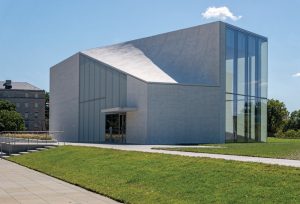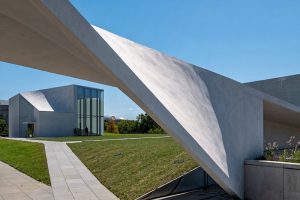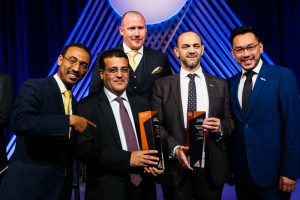The REACH, a 72,000-square-foot expansion of the John F. Kennedy Center for the Performing Arts in Washington, DC, received the Overall Excellence Award in the 2020 American Concrete Institute’s (ACI) Excellence in Concrete Construction Awards program. The REACH is comprised of three prominent pavilions connected by studios, classrooms, and a parking structure below an interwoven green roof. This article provides insights into the execution of some of the project’s outstanding features.

Overview
At first glance, the three pavilions of the REACH – the Welcome, Skylight, and River Pavilions – appear to be three independent structures planted within a terraced landscape covering about 5 acres. However, upon further inspection, the terrace is a green roof above two levels of interconnected corridors, performance spaces, practice halls, and a parking structure below.
The green roof is supported by a post-tensioned slab incorporating Cobiax void formers to minimize dead load. Void formers significantly reduce the nonstructural concrete from the middle of the slab, effectively decreasing the dead load and maximizing the overall slab span. During the construction phase, some voids had to be eliminated to ensure enough anchorage capacity for formwork loads without impacting the original design parameters for span and deflection. The post-tensioning was also reviewed to ensure adequacy for construction loads.
Throughout, the REACH complex features a variety of exposed concrete finishes and structural and architectural components. A 2-foot-thick mat supports the base of the structure on existing caissons and new H-piles, whereas the level above comprises solid slabs (both one-way and two-way), two-way voided slabs, and two-way post-tensioned voided slabs. The green roof structure primarily contains one-way post-tensioned voided slabs except for the roof structure over Studio K, which is a post-tensioned one-way slab with a sawtooth soffit.
The Welcome Pavilion
The Welcome Pavilion provides a spacious main entry and visitor lobby for the REACH. Prominent features include 40-foot-tall, board-formed concrete walls, cantilevered concrete stairs, a conical roof over the uppermost entryway, and a vaulted lower ceiling near the lower entryway.
The upper roof slab and beams of the Welcome Pavilion were cast on elevated forms supported by shoring up to 40 feet tall. The conical section of the upper roof created many unique design and construction challenges because the shoring had to resist both horizontal and vertical forces. Additionally, the distinctive shape required a dampproof membrane between two layers of concrete and an architectural concrete finish.
The Skylight Pavilion
The Skylight Pavilion is the project’s crowning achievement, featuring an expansive atrium and a 145-foot-long, 42-foot-tall, asymmetrically curved wall. Overlooking the Potomac River, natural light from the slotted roof and large, curved windows in the south-facing wall create an elegant gathering space. On the north face of the pavilion, a vertical exterior wall serves as a large outdoor projection screen for audiences to enjoy movies and simulcasts.
The Skylight Pavilion is a very complex structure and the largest of the three pavilions. The “wave-shaped” wall is curved and warped, with each spline unique. The base includes the large opening for the curved window; at the top, it is loaded and laterally supported by a reinforced concrete roof that is slotted for skylights at each end. The base of the curved wall was complicated even further because it extended below the historic flood elevation and required a membrane sandwiched between two placements of concrete to prevent flooding of the enclosed space. The high mass, complex geometry, and key design features of the curved wall provided tremendous challenges for the construction team.
After being awarded the formwork contract, PERI performed a complete analysis of a 3-D model of the wall formwork to assess constructability. While the design team had specified that the wall be pumped from the bottom and placed monolithically, PERI was concerned about the high pressures from both the self-consolidating concrete (SCC) and the corresponding resultant forces in the two stop-end systems at each end of the wall. In lieu of a monolithic placement, PERI first considered a two-lift placement and calculated the construction loads to be transferred to the voided slab of the permanent structure below.
The engineer of record (EOR) analyzed these anticipated formwork reactions, which showed that the permanent structure below could not support the construction loads resulting from a full-length, two-lift placement. To avoid overloading the supporting structure, PERI recommended a three-lift placement. This increase in the number of placements significantly impacted the material and labor costs. Although the outside formwork could be left in place for all placements regardless of the number, the change from two-lift construction to three-lift construction added about 50% to the quantity of forms and attachments needed for both the outside and inside formwork assemblies. This modification had the greatest impact on the inside face of the formwork, as each lift of interior forming and falsework had to be stripped and the wall braced before the subsequent lift of forming and falsework could be set. Because each spline of the wall is unique, each panel of formwork also had to be unique, and each connection and bracing condition had to be designed and detailed independently.
Early on, formwork designers anticipated that the curved wall would need to be tied into and placed with end wall returns to facilitate forming the bulkheads at each end and prevent cracking in the curved wall. Because it could not be reasonably assumed that the wall was self-supporting until the roof slab was tied into the curved wall, it was imperative that much of the formwork and shoring remain in place and that bracing be provided for the stripped inside face of the wall until the roof slab had been placed and gained strength. This requirement added substantially to the rental costs for the formwork and shoring for the outside face, plus the formwork, shoring, and labor for the inside face. Ultimately, leaving the inside face of the formwork and shoring in place also complicated the shoring design for the roof slab and sequencing for the entire operation, including transfer beams bisecting the roof at the top of the wall and supporting the slab edge at the skylights.
As the formwork design was developed, PERI initially assumed that the form ties would be horizontal. This would have allowed the back of each formwork panel to be fabricated perpendicular to the ties, thus reducing the need for custom detailing of the stiffbacks. However, the design team rejected this concept, as the desired aesthetic instead required each form tie to be perpendicular to the face of the finished concrete. This condition added to the engineering costs for the formwork because it required that each stiffback was chorded between ties rather than simply running vertically for the length of the panel. The articulated stiffbacks required more intricate bracing for each panel, so the complexity of the bracing calculations and associated details increased significantly.

The River Pavilion
Located at the southernmost end of the Kennedy Center campus, the River Pavilion houses a café with views of the Potomac River and a new pedestrian bridge. The smallest of the three aboveground structures in the REACH, the River Pavilion continues the themes of the other structures with a conical roof slab and an asymmetrical curved wall with board-formed finishes.
As with the curved wall of the Skylight Pavilion, the curved wall of the River Pavilion was constructed with white SCC and tongue-and-groove board form lining. While this shorter wall was constructed in two lifts rather than three, the wall’s proximity to the cut for the Rock Creek Parkway made it necessary to anchor the formwork bracing only on the interior side. Because there was no slab to support the exterior forms, heavy channel strongbacks were used to resist the loads of the asymmetrical placement. These channels extended down one level and were anchored into the foundation wall below.
Studio K and the Justice Forum
Over 11,500 square feet of the interior wall surfaces of the REACH were constructed with a crinkle concrete texture featuring 3-inch-deep random folds and angles designed to break up sound waves and avoid reverberation between parallel walls. Studio K is the largest space with this feature, followed by the Justice Forum auditorium.
Steven Holl, the REACH’s architect, came up with the crinkle concrete’s unique form pattern by bending metal sheets. Subsequently, he worked with Fitzgerald Formliners and Form Services, Inc., to transfer the irregular pleated textures to 4- × 10-foot elastomeric form liners. During the liner fabrication process, special care was taken to ensure that the folds in the pattern would not inhibit stripping of the formwork.
The crinkle concrete walls are not only decorative and sound-enhancing but also serve as primary structure supports for the portion of the buildings where they reside. The exteriors of the Studio K and Justice Forum auditorium walls were constructed with board-formed surfaces. The forms included proprietary crack inducers to minimize the visual impact of contraction joints. The 22-foot-tall walls were placed full height with a gray, high-slump concrete mixture.
Challenges
The REACH’s unique features demanded extra attention from the planning phase through execution. A few of these features are included below.
Much of the project comprises exposed concrete walls that define the aesthetics of the REACH. The exterior walls were constructed using self-consolidating white concrete with tongue-and-groove board form on the outside face. The finish on the inside face of the exterior walls varies. Many walls were placed with board form on one side of the wall and a “crinkle” liner on the other. These varied finishes created challenges with sequencing and stripping the formwork.
Further, tie holes had to be laid out in a regular pattern – aligning both vertically and horizontally. This was difficult to achieve on irregular shapes and at corners, as they resulted in high reaction loads. Construction joint locations were limited to wall corners, resulting in the need for large quantities of formwork and form liner materials, particularly boards used to create the board-formed finishes.
The length, height, and asymmetrical shape of the curved wall on the Skylight Pavilion required careful analysis of its effects on the void slab below. Placement height and formwork pressure affected construction loads, labor and formwork costs, and schedule. The position of the curved and asymmetrical wall in the River Pavilion created another set of challenges, as a steep embankment made it impossible to brace the formwork on the concave side of the wall.
The shapes of mockup panel assemblies were verified at the fabrication plant and job site using laser scanners. When formwork was placed for the feature wall of the Skylight Pavilion, a laser scan was also performed to ensure proper geometry. A final scan was performed on the cast concrete to verify that the formwork had not moved during placement.
Demonstrated Excellence
The REACH at the Kennedy Center excels at many levels. Outside, its brilliant and sculptural forms create striking icons both day and night. Inside, its textured walls provide aesthetic features as well as acoustic functions. It truly is a demonstration of excellence in concrete construction.■
Portions of this article were previously published in Concrete International, March 2021. It is reprinted with permission.
Project Team
Architect: Steven Holl Architects
Structural Engineer: Silman
Façade Consultant: Thornton Tomasetti
General Contractor: Whiting-Turner
Concrete Contractor: The Lane Construction Corp.
ACI Excellence in Concrete Construction Awards
The American Concrete Institute (ACI) Excellence in Concrete Construction Awards program offers a new self-nomination option, making it easier for companies and organizations to achieve recognition for their work.

ACI’s Excellence in Concrete Construction Awards recognize projects in seven categories that exhibit innovation and complexity and showcase the value provided by concrete as a material.
For companies or organizations that do not have an ACI chapter or partner award program available in their area, self-nomination is a solution. “The option for self-nomination is a marvelous enhancement of the awards program, ensuring recognition for the best of what’s out there,” said Michael J. Paul, former Chair of the International Project Awards Committee (IPAC).
Entries for the 2022 ACI Excellence in Concrete Construction Awards are due Friday, April 29, 2022. To learn more about the Awards Program or self-nominate a project, visit https://bit.ly/36G93SD.
We are excited to see a lessening of the pandemic’s impact on our authors and advertisers and expect to have more normal page counts in the future. As a result, we have taken the opportunity to showcase the work that other organizations do in supporting SEs by reinvigorating our Guest Column program. It is a pleasure to have these organizations add to STRUCTURE’s knowledge base. If your organization would like to submit an article proposal, please contact Chair@STRUCTUREmag.org.
